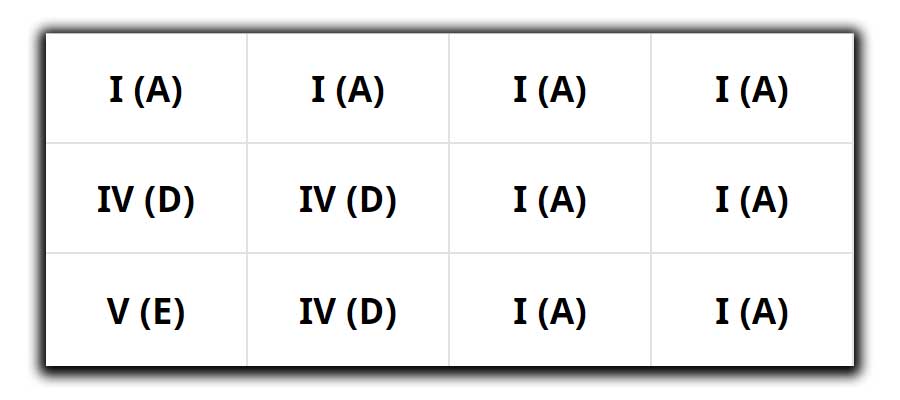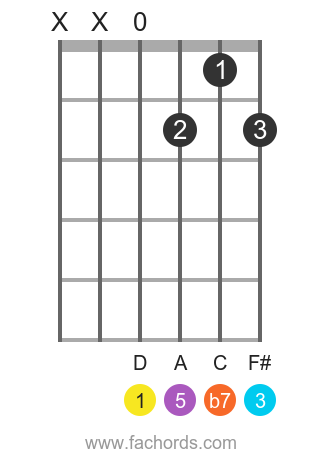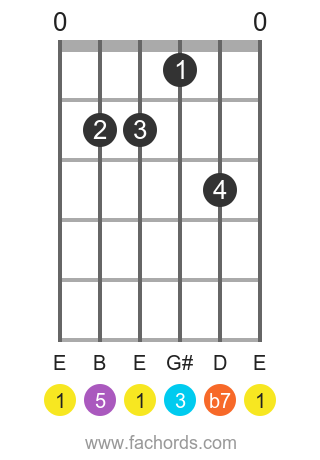Blues Guitar Solos
How To Solo Over a 12-Bar Blues
In this tutorial, I'll give some suggestions that will help you improve your lead guitar skills and create great solos.
I'll present a framework that you can use to analyze any chord progression and select which scales (or better, notes) to play in order to flow with the chords and not against them.
We're going to use a 12-bar Blues progression in the key of A because it matches wonderfully with pentatonic scales and, most important, blues soloing lies at the foundation of any lead guitar learning path.
So, let's start!
First of all, let's see what not to do to play a great guitar solo:
- Running fast up and down scales mindlessly
- Play all the notes in scale without caring about the underlying chords
- Not being aware of chord changes
In a nutshell, playing a great solo means flowing smoothly along with the chord progression, highlighting the chord tones that create or resolve tension in every chord change.
So the first thing first we need to do is to analyze the chords composing our chord progression.
12-Bar Blues Progression in the key of A
Here are the chord diagrams of the chords in an A 12-Bar Blues progression.
The diagrams show also the tones and the notes in the chord; this information will be useful later in this article (my complete ebook, Chords Domination, has about 800 diagrams like these)
The picture below shows the measure structure of a 12-Bar blues song.
Please pay attention at what measure chord changes happen, because this will be extremely important in choosing the right notes to play:

So, as shown above, the chord changes in a 12 Bar blues are:
- 4 bars playing chord I (A7)
- 2 bars playing chord IV (D7)
- 2 bars playing chord I (A7)
- 1 bar playing chord V (E7)
- 1 bar playing chord IV (D7)
- Turnaround: 2 bars playing chord I (A7)
The last 2 bars are the so-called turnaround, and can have many possible variations.
In this tutorial we'll stick to its simplest form, by playing chord I (A7) for all the two bars. (if you need help with Roman Number notation, check our Nashville Number System tutorial)
Which Scales Should I Use to Solo Over These Chords?
Here below we listed some common approaches to use when soloing over a 12 bar blues progressions in the key of A.
In the following of this tutorial, we're going to analyze these choices.
- 1) Play the A minor pentatonic scale on all the 3 progression chords.
- 2) Play the A major pentatonic scale on all the 3 progression chords, except for the IV (D7) on which you play the A minor pentatonic (we'll see later why)
- 3) Play the minor pentatonic scale with the root of each chord (A minor pentatonic, D minor pentatonic, E minor pentatonic)
- 4) Play the major pentatonic scale with the root of each chord (A major pentatonic, D major pentatonic, E major pentatonic)
- 5) Play the dominant arpeggio of each chord
- 6) Mix minor pentatonic scale and dominant arpeggios
- 7) Bonus: other cool and uncommon scales to try over a dominant chord
Ok! Let's have a look at all these approaches:
Play the A minor pentatonic scale over all the chords
The easiest way to approach a blues solo is to use the minor pentatonic scale of the key for all the chords.
So, in the key of A, we're going to play the A minor pentatonic scale.
This is a simple and safe way to create some nice melodies, but eventually, it will become boring!
A7 I

A Minor Pentatonic
D7 IV

A Minor Pentatonic
E7 V

A Minor Pentatonic
Play the A major pentatonic scale on all the 3 progression chords, except for the IV (D7)
Of course, we are also free to play the major pentatonic scale of the key.
But there is a problem.
In the key of A, we'll use the A major pentatonic.
When the underlying harmony will play the D7 (IV), the C# present in the A major pentatonic scale clashes terribly with the chord tones in D7, which is composed of the notes D, F#, A, and C.
A safe solution is to use the A minor pentatonic on D7 (IV degree of the progression).
A7 I

A Major Pentatonic
D7 IV

A Minor Pentatonic
E7 V

A Major Pentatonic
Play the minor pentatonic scale with the root of each chord
Another way to add variety to our solos is to play the correspondent minor pentatonic of each chords, so we'll use A minor, D minor and E minor pentatonic scales.
You can shift the same shape up or down the neck, or learn the pentatonic patterns with root on 6th and 5th strings.
A7 I

A Minor Pentatonic
D7 IV

D Minor Pentatonic
E7 V

E Minor Pentatonic
Play the major pentatonic scale with the root of each chord
Same process as shown above but with major pentatonic scales.
You can also mix these two last approaches during the song.
A7 I

A Major Pentatonic
D7 IV

D Major Pentatonic
E7 V

E Major Pentatonic
Play the dominant arpeggio of each chord
Here the fun begins.
I've stated multiple times on these pages, what differentiates a great solo from a not-too-good one is the ability to flow with the underlying harmony, highlighting the dynamics that chord tones create.
That's the reason I've included 44 chord tones full fretboard maps in my Chords Domination ebook.
In the case of a blues solo, a great way to achieve this effect is to forget scale for a moment and focus on arpeggio.
Playing an arpeggio simply means play the note of a chord one at a time.
Here below you find the arpeggio shapes for A7, D7, and E7 chord.
I included different shapes for a purpose, so you'll be forced to learn 3 different fingerings instead of moving the same pattern up and down the neck :-)
A7 I

A7 Arpeggio
D7 IV

D7 Arpeggio
E7 V

E7 Arpeggio
Mix minor pentatonic scales and dominant arpeggios
And finally, with this last strategy, you'll achieve the level of Top Blues Master. In this stage, you're going to mix the minor sound of the minor pentatonic scale, and the major sound of dominant arpeggios.
All the great blues masters, like Eric Clapton, Stevie Ray Vaughan, B.B. King, used this trick to enhance their expressivity and feeling.
All you need to do is to use the minor pentatonic as a foundation, and add the notes of the arpeggio of the chord your playing over.
A7 I

A Minor Pentatonic Scale +
A7 Arpeggio
D7 IV

A Minor Pentatonic Scale +
D7 Arpeggio
E7 V

A Minor Pentatonic Scale +
E7 Arpeggio
Bonus: other Uncommon Scales to try over a Dominant 7th Arpeggio
This is pretty advanced stuff, but I'll leave it in case you want to experiment a bit.
Here below you find a list of scales that will sound good over a C7 dominant arpeggio (you can move the pattern up or down the neck for other roots).
For a complete list of scales to play over any given chord type, please refer to my ebook, Scales over Chords
Here's an excerpt showing which scales to play over a C7 chord:
- C Mixolydian scale (1 2 3 4 5 6 b7)
- C Mixolydian b6 scale (1 2 3 4 5 b6 b7)
- D Aeolian b5 scale (1 2 b3 4 b5 b6 b7)
- D Minor scale (1 2 b3 4 5 b6 b7)
- E Locrian scale (1 b2 b3 4 b5 b6 b7)
- E Super Locrian scale (1 b2 b3 b4 b5 b6 b7)
- F Major scale (1 2 3 4 5 6 7)
- F Melodic Minor scale (1 2 b3 4 5 6 7)
- G Dorian scale (1 2 b3 4 5 6 b7)
- G Dorian b2 scale (1 b2 b3 4 5 6 b7)
- G# Lydian Augmented scale (1 2 3 #4 #5 6 7)
- A Phrygian scale (1 b2 b3 4 5 b6 b7)
- Bb Lydian Dominant scale (1 2 3 #4 5 6 b7)
- Bb Lydian scale (1 2 3 #4 5 6 7)
- C Lydian Dominant scale (1 2 3 #4 5 6 b7)
- D Mixolydian b6 scale (1 2 3 4 5 b6 b7)
- E Aeolian b5 scale (1 2 b3 4 b5 b6 b7)
- F# Super Locrian scale (1 b2 b3 b4 b5 b6 b7)
- G Melodic Minor scale (1 2 b3 4 5 6 7)
- A Dorian b2 scale (1 b2 b3 4 5 6 b7)
How To Solo Over A Blues Progressions: Conclusions
I hope you have now some new ideas on what to do when soloing over a blues chord progression.
I can't stress it enough, for creating a great solo you must be fully aware of the underlying chords and try to match your melody to the chord tones as smoothly as possible.
Using arpeggios and mixing them with the old, safe, pentatonic scale, is a great strategy to start from.
Don't forget to join the free newsletter and get free downloads and updates. Have fun!


